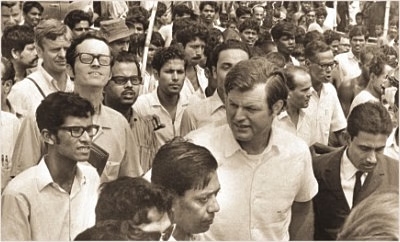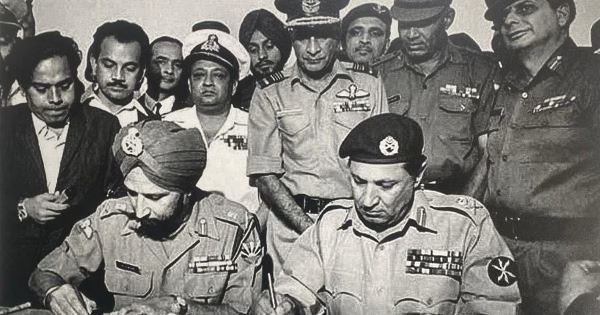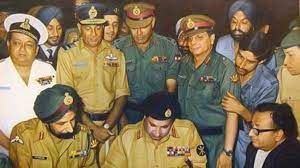Starting from mid-February till January 10, 1972, this brief timeline mentions every important event of the Bangalee’s struggle for independence and efforts to thwart it through genocide by Pakistan, its allies, and local collaborators, like the Pace Committee, Razakar, and al-Bard forces.
This timeline will remind you about diplomacy and dirty politics, the deadliest genocide in world history, and how the campaigns for an independent Bangladesh finally defeated all the evil forces.
Readers who already have a clear knowledge of Bangladesh’s Liberation War will be able to understand the reasons behind the political ups and downs and social changes in the last 54 years and where we are heading towards.
February 15: By then, the Pakistan military junta has decided that the Bangalees should, if necessary, be frustrated by force of arms from achieving the autonomy on which they were so plainly bent. President General AM Yahya Khan continues to seek a political solution, apparently, but the military build-up of West Pakistan forces in East Pakistan also continues to thwart the birth of Bangladesh
February 19: The army moves out of their cantonment in Dhaka and begins to set up checkpoints and machine gun posts around the town.
February 21: Yahya dismisses his ten-man civilian cabinet and calls in all five provincial governors and martial law administrators. The army takes over full control
Documentation of 1971 Hindu genocide in Bangladesh
February 26, 27 and 28: The Awami League leadership meets in conference in Dhaka to settle their draft constitution for submission to the Constituent Assembly
February 28: Zulfikar Ali Bhutto demands that either the 120-day limit for the Constituent Assembly be removed, or the opening session be postponed, threatening a hartal (general strike) throughout West Pakistan
March 1: Yahya postpones National Assembly scheduled for March 3
March 2: Yahya imposes curfew; Bangladesh’s flag is raised at Dhaka University; hartal called for March 3 by prime minister-elect Sheikh Mujibur Rahman

March 3: Yahya announces meeting with political leaders on March 10
March 3: Sheikh Mujib announces non-cooperation, non-violent movement from Paltan rally
March 1-3: 170 individuals killed in Dhaka
March 7: Sheikh Mujib declares all-out movement for independence
March 19: 50 killed in clash with army in Jaydevpur
March 24: Army kills 1,000 in Syedpur, Rangpur and Chittagong

March 25: Yahya declares state-of-emergency in East Pakistan, launches Operation Searchlight
March 26: Sheikh Mujib is arrested after declaring independence
March 27: Indira Gandhi expresses full support for East Pakistan independence; proclamation of independence read out by several AL leaders and Major Zia from Kalurghat radio station
April 2: Soviet Union appeals to West Pakistan for a ceasefire
April 3: Malaysia and Turkey governments express support for Yahya
April 4: Bangalee army officials hold first strategic meeting
April 6: Soviet President Podgorny requests Yahya to stop bloodshed; reply same: “no one should interfere in the internal matter of Pakistan”
April 6: Pakistan drops bombs in Chandpur Puran Bazar in their air attack

April 6: Jamaat-e-Islami chief Ghulam Azam, other Islamist leaders meet Governor and Marshall Law Administrator Lt General Tikka Khan, the infamous “Baluchistan Koshai”
April 7: US appeals to West Pakistan for a ceasefire
April 7: Ghulam Azam in a statement says we believe as patriots of East Pakistan, anywhere that a freedom fighter is spotted, then and there they will be attacked. Utmost support will be provided to the military also in eradicating these freedom fighters
April 7: Islamic Republic Party’s president Maulana Nurujjaman Khan says in a statement in Dhaka that the Pakistan Military authorities are deployed in daunting and eradicating the freedom fighters and patriotic citizens will support the military in protecting the interest of the nation
April 8: Ghulam Azam issues a statement, asking patriotic Pakistanis to destroy Indian agents or anti-Pakistan elements and infiltrators
April 10: Provisional Bangladesh government-in-exile formed
April 11: Radio address by Prime Minister Tajuddin Ahmad
April 12: MAG Osmani made commander of the Bangladesh Armed Forces
April 12: China expresses support for Yahya
April 15: Peace Committee formed
April 17: Provisional government-in-exile takes oath
April 19: Convention Muslim League President Fazlul Kader Chowdhury meets General Tikka Khan
April 20: Tikka Khan orders AL leaders Tajuddin Ahmad, Syed Nazrul Islam, Abdul Mannan, Tofayel Ahmed and the People’s Editor Abidur Rahman to be present in military court at 8am on April 26
April 21: Acting president Syed Nazrul appoints Justice Abu Saeed Chowdhury as special representative of Bangladesh Diplomatic missions in foreign countries
April 23: PM Tajuddin welcomes British MP Douglas Mann in Benapole
April 28: Through the Shadhin Bangla Betar Kendra, Tajuddin requests India to recognize independent Bangladesh and help with arms support
April 28: Soviet Prime Minister Alexy Kessigin in a message urges Yahya to immediately stop the bloodshed and mass murder
May 2: In Pirojpur, Siraj Sikder forms a committee to conduct guerrilla-style wars. The committee elects Jahanara Begum (wife of Siraj Sikder) as the chairperson, Shahnewaz as the commander in chief, Mujib in the public relations and Mahtab as a member. The camp area is divided into several sectors
May 3: In the US Senate, Senator Edward Kennedy urges the United Nations to take necessary steps regarding the Bangladesh crisis. He also urges the US government to respond to the Indian government’s appeal for aid for the refugees from Bangladesh

May 5: First unit of the Razakar force formed in Khulna
May 6: India estimates 1.2 million fled from East Pakistan
May 19: UNHCR, UNICEF, WFP provide humanitarian assistance to refugees
May 15-August 15: Yahya carries out Operation Jackpot
May 25: Operation Searchlight ends
July 7: First brigade, “Z Force,” formed with Major Zia as the commander
July 7: US president’s adviser Henry Kissinger meets Indira Gandhi, Foreign Minister Sharan Sing
July 7: Senator Frank Church calls upon government to bring back the arms-loaded ship sent to Pakistan
June 18: Ghulam Azam arrives in Lahore to meet Yahya
June 23: UK imposes military sanctions on West Pakistan
July 9: Nijam-e-Islam in a statement says they will not compromise with miscreants (freedom fighters)
July 11: Henry Kissinger meets Yahya
July 11-17: Sector Commanders’ Conference held in Kolkata presided over by PM Tajuddin
July 29: General Tikka Khan calls for forming Mujahid Bahini to fight the Muktibahini
July 29: Ghulam Azam thanks Tikka Khan for omitting some topics from textbooks, which will help make the citizens pure Pakistanis
August 1: The Concert for Bangladesh is held in Madison Square Garden, New York
August 9: Pakistan military administration in Rawalpindi declares that the trial of Sheikh Mujibur Rahman will start from August 11
August 14: Celebrating the Independence Day of Pakistan, Ghulam Azam said: “Those who are observing Independence Day this year love Pakistan more than their lives. … We are struggling to restore unity of Pakistan. It will be tough to sustain as a Muslim if the country does not sustain”

August 15: Senator Edward Kennedy, chairman of the refugee affairs subcommittee, meets Indira Gandhi and Sharan Sing in New Delhi over Bangladesh refugee affairs
August 15: Pakistan’s former foreign minister Hamidul Haque says in London: “Those who dream of an independent Bangladesh are mistaken, like Mir Zafar”
August 15: Protesting the statement of UN Secretary General U’Thant, the Pakistan government says: “Sheikh Mujib is the enemy of the country and nation. His trial is totally internal matter of Pakistan. UN has crossed the limit interfering in the trial of Sheikh Mujib”
August 30: Pakistan Army crackdown on Dhaka guerrillas
August 31: Pakistan government recognizes Razakar force, pays salaries from USAID funds for cyclone-affected people
September 3: Dr Abdul Motaleb Malik is made Governor of East Pakistan to replace Tikka Khan
September 5: Yahya releases many suspects and declares a general amnesty, saying it will remove all manner of doubt, fear and anxiety from the minds of those who may have committed offences during the course of and due to the heat generated by political disturbances in East Pakistan and gone outside the country or underground; he invites men to return to their homeland and rejoin their families and resume their normal vocations; there was virtually no response
September 17: Governor Malik declares a 10-member provincial cabinet. The ministers are AKM Yusuf of Khulna, Abul Kashem of Rangpur, Abbas Ali Khan of Bogra, Akhter Uddin Khan of Barisal, ASM Solayman of Dhaka, Mohammad Isahaq of Pabna, Nawajesh Ahmed of Kushtia, Obaidullah Mazumder of Noakhali, Shamsul Haque of Chittagong and Aungshu Pru Chowdhury of Chittagong Hill Tracts. Except for Aungshu, the rest take oath as ministers
September 17: PDP Chief Nurul Amin says: “We are not totally out of danger yet. Enemies are still crawling all around us”
September 17: Ghulam Azam meets trainee Razakars at Mohammadpur Physical Education Centre, saying only those who believe in Muslim integrity are ready to sacrifice lives for Pakistan and they are the actual assets of the country
September 17: General Tikka Khan was seen in a UNICEF’s SUV, reports Joy Bangla newspaper; he visits Mymensingh and Netrokona, and meets Al-Badr members and Razakars at Tarail in Kishoreganj
September 23: Islami Chhatra Sangha chief Matiur Rahman Nizami says madrasa students are trying to save the country; they are the true torchbearers of the patriots. Because they love Islam, they love Pakistan. Meanwhile, students of universities and colleges, who get all sorts of facilities, are acting against the state
September 28: Bangladesh Air Force starts functioning
October 1: British Foreign Minister Sir Alec Douglas-Home says that undoubtedly the Pakistan-India situation has gained importance, adding the situation would end soon
October 1: Cooperative society, fisheries, and minority state minister Aungshu Pru Chowdhury tells APP that India’s publicity regarding torture on minorities is completely false. The armed forces are ensuring their security
October 5: Jamaat forms five-member body led by Ghulam Azam to oversee by-polls
October 16: General Yahya asks Soviet President Nikolai Podgorny in Tehran to take necessary steps for the unity and solidarity of Pakistan
October 16: Ghulam Azam tells a Dhaka rally that the people need to wake up from dreams that India would free East Pakistan
October 16: UN Assistant General Secretary Palmark Henry tells a press conference that though the guerilla forces could not stand against the Pakistan military, they are obstructing the relief work
November 8: US imposes military sanctions on West Pakistan
November 9: Bangladesh Navy formed
November 21: Bangladesh Armed Forces formed
November 23: General Yahya declares a state of emergency
November 27: Ghulam Azam tells press conference in Rawalpindi: “Offence is the only way to defend”
November: General Yahya receives military assistance from Saudi Arabia, Jordan, Libya, Iran
November 30: Indian PM Indira Gandhi appeals for withdrawal of army from East Pakistan
December 3: Pakistan Air Force launches strikes on 11 airfields in north-western India, known as Operation Chengiz Khan
December 3-4: India retaliates with air strikes
December 4: US government refers the West Pakistan Army offensive on East Pakistan to the UN Security Council
December 6: Soviet Union vetoes a UN Security Council resolution for ceasefire
December 6: India provides diplomatic recognition to provisional government
December 7: UN General Assembly appeals for ceasefire and troop withdrawal
December 11: US pressures both India and Pakistan to accept ceasefire offer; deploys nuclear-armed USS Enterprise in the Bay of Bengal
December 11: The allied air attack suspended at the UN’s request to evacuate foreign nationals from Dhaka. General Niazi inspects anti-aircraft guns at Dhaka airport, tells his troops to resist the allied force at any cost; Pakistan Major General Rao Farman Ali urges an emergency ceasefire to evacuate Pakistanis from Dhaka
December 13: Soviet Navy deploys warships
December 15: UN General Assembly demands ceasefire
December 16: Pakistan Armed Forces—its land, air and naval forces, all paramilitary forces and civil armed forces under the Eastern Command led by Lt Gen AAK Niazi—surrender to Lt Gen Jagjit Singh Aurora of the Indian and Bangladesh Forces in the Eastern Theatre at the Racecourse Maidan in Dhaka

December 22: The provisional government of Bangladesh arrives in Dhaka from exile

December 23: Bhutto decides to release Sheikh Mujib from prison and put him under house arrest, holds a meeting at his Dak-Bungalow in Rawalpindi
December 24: The Pakistani cabinet agrees to release Sheikh Mujib
December 27: Bhutto meets Sheikh Mujib again for negotiations
January 8, 1972: Bhutto sees off Sheikh Mujib at Rawalpindi airport; the bird has flown, he later told newsmen; a diplomat at the British Foreign & Commonwealth Office receives him and escorts him to Claridge’s Hotel in London’s Mayfair; British Prime Minister Edward Heath welcomes Sheikh Mujib at 10 Downing Street; he later addresses a press conference at Claridge’s, declaring a free Bengali country was an unchallengeable reality

January 10: The Royal Air Force Comet refuels at its bases in Cyprus and Oman before landing in Delhi in the morning; at a meeting, Sheikh Mujib requests Indira Gandhi to advance the withdrawal of Indian forces from Bangladesh to March 31 from June 30, to which Indira agrees; after addressing a rally in Delhi, he flies to Dhaka on the Royal Air Force Comet and is given 21 cannon salutes and a guard of honour; Sheikh Mujib addresses a crowd of a million Bangalees at the Racecourse Maidan and expresses gratitude to the sacrifice of 30 lakh martyrs and calls for nation-building.


Leave a Reply
You must be logged in to post a comment.